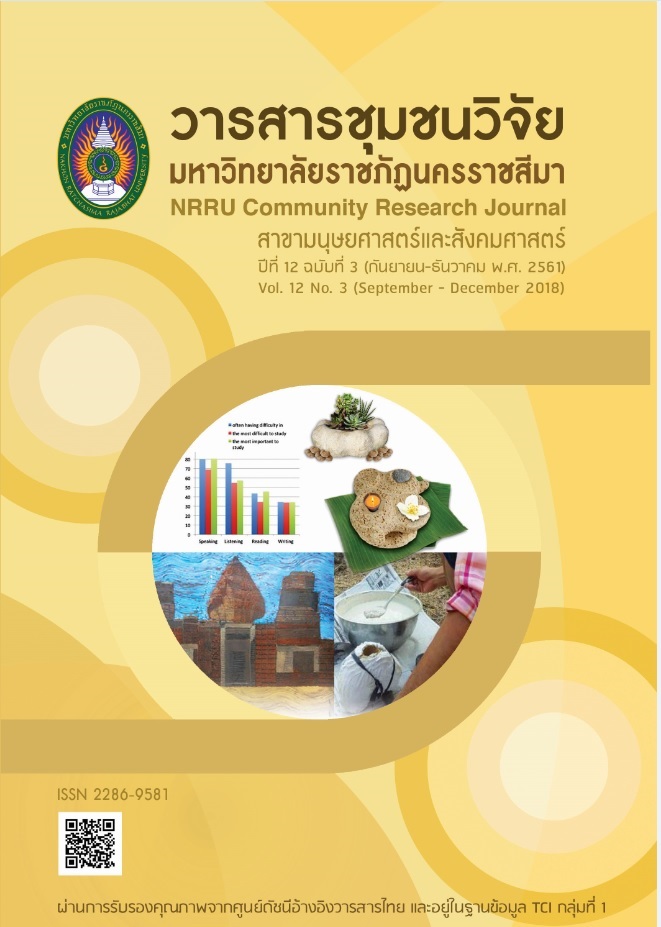NEEDS ANALYSIS TO ENGLISH FOR OCCUPATIONAL PURPOSES: ENHANCING COMMUNICATION SKILLS OF PERFORMING ARTS STUDENTS
Keywords:
EOP, Students' demands, Preforming Arts, University studentsAbstract
Universities have focused their attention on implementing English for Occupational Purposes (EOP) with the aim of increasing institutional visibility at an advanced level. EOP is a student-centred learning whose main features are: special attention to students’ needs; inclusion of content-related material and activities; and the use of innovative teaching methodology. The analysis of those needs is a cornerstone of any EOP course, as it provides specialists with essential information for developing English for performing art students. The aim of this study was to analyse students’ needs regarding English course of the 2nd year students at the Performing Arts Program, Faculty of Humanities and Social Sciences, Nakhon Ratchasima Rajabhat University, Thailand. 78 students from academic year of 2016-17 composed as the research sample. Questionnaires and interviews were used. Results shows that students perceive speaking and listening can be the most difficult skills but also the most needed for their professional future. In addition, they prefer to study Performing Arts contents by means of interactive strategies and a student-centred learning. Implementing Preforming Arts related EOP courses is a necessary step for the academic and professional development of students. Special focus must be put on speaking and listening, as well as more practical teaching strategies that allow students to be active during the EOP class.
References
Benesch, S. (1996). Needs analysis and curriculum development in EAP: an Example of a critical approach. TESOL Quarterly, 30(4), 723-738.
Chostelidou, D. (2010). A needs analysis approach to ESP Syllabus Design in Greek tertiary education: a descriptive account of students’ needs. Procedia Social and Behavioral Sciences 2, 4507-4512.
Dehnad, A., Bagherzadeh, R., Bigdeli, S., Hatami, K., & Hosseini, F. (2010). Syllabus revision: a needs analysis Study. Procedia Social and Behavioral Sciences 9, 1307-1312.
Domínguez, G. A., & Rokowski, P. E. (2005). Bridging the Gap between English for Academic and Occupational Purposes. ESP World. Retrieved March 3rd, 2018, from http://www.esp-world.info/Articles_2/Bridging%20the%20gap%20between%20English%20for%20Academic%2 0and%20Occupational%20Purposes.html
Dudley-Evans, T., & St. John, M. J. (1998). Developments in English for specific Purposes. Cambridge : Cambridge University Press.
Friedenberg, J., Kennedy, D., Lomperis, A., Martin, W., & Westerfield, K. (with van Naerssen, M. (2003). Effective practices in workplace language training: Guidelines for pro- viders of workplace English language training services. Alexandria,VA : TESOL.
Hakuta, K., Butler, Y.G., & Witt, D. (2000). How long does it take English learners to attain proficiency? University of California Linguistic Minority Research Institute Policy Report 2000-1. Santa Barbara, CA: University of California-Santa Barbara. Retrieved March 12th, 2018 from http:// www.usc.edu/dept/education/CMMR /FullText/Hakuta_HOW_LONG_DOES_IT_TAKE.pdf
Hutchinson, T., & Waters, A. (1987). English for specific purposes: A learning- centered approach. Cambridge : Cambridge University Press.
Johns, A. M. & Dudley-Evans, T. (1991). English for specific purposes: International in scope, specific in purpose. TESOL Quarterly 25(2), 297-313.
Jordan, R. R. (1997). English for academic purposes: A guide and resource book for teachers. Cambridge : Cambridge University Press.
Kim, D. (2008). English for Occupational Purposes : One Language?. Continuum books Publishing. Retrieved December 11th, 2017 https://books.google.co.th/books?isbn=0826497349
Miyake, M. & Tremarco, J. (2005). Needs Analysis for Nursing Students Utilizing Questionnaires and Interviews. Kawasaki Journal of Medical Welfare 1, 23-34.
Munby, J. (1978). Communicative syllabus design. Cambridge: Cambridge University Press.
Nunan, D. (1988). The Learner-Centred Curriculum. Cambridge: Cambridge Applied Linguistics.
Phan, L. (2013). Issues surrounding English, the internationalisation of higher education and national cultural identity in Asia: A focus on Japan. Critical Studies in Education 54(2), 160- 175.
Promnath, K., & Tayjasanant, C. (2016). ASSA, P., Switching of Teachers in ESP Classes-Thai Code-English, 201(516). Retrieved November 22, 2017, from http//www.culichula.ac.th/Publication sonline/files/article/X0bKTanGxMWed110239.pdf
Richards, J. C., & Schmidt, R. (2010). Longman Dictionary of Language Teaching and Applied Linguistics (4th ed.). London : Longman.
Rodríguez, X. (2006). A English for Occupational Purposes Model Designed for Workplace. Costa Rica Cartago, Costa Rica 26-36.
Saragih, E. (2014). Designing ESP Materials for Nursing Students Based On Needs Analysis. International Journal of Linguistics 6(4), 59-70.
Ulucay, S., & Demirel, O. (2011). Perceptions of Professionals, Academicians and Current and Graduate Students on designing an ESP Curriculum for Logistics Department. Procedia Social and Behavioral Sciences 15, 794-800.
Wiriyachitra, A. (2002). English Language Teaching and Learning in Thailand in this Decade. Retrieved August 2, 2017, from Thai TESOL Focus. http:www.//apecknowledgebank.com





